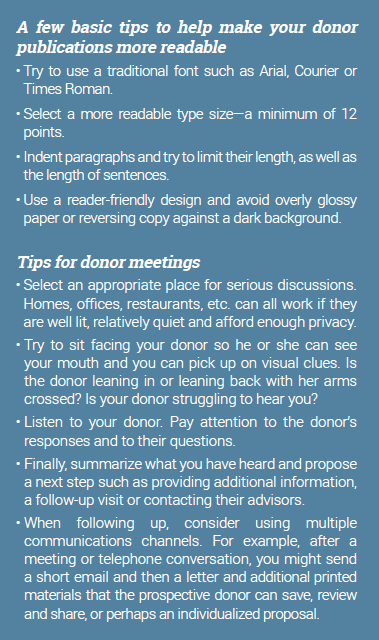By Barlow Mann, J.D.
Make sure you are communicating effectively with your best prospects for major and planned gifts.
It doesn’t take a pinball wizard to understand that communications with your donors can be challenging, but they don’t have to be. Read on to see if you have inadvertently overlooked some of the primary obstacles to communicating effectively with many of your best prospects for larger gifts.
Never heard it
The majority of prospective planned gift donors are middle-aged or older, and a surprising number fall into that older category. Hearing is one of the first casualties of the aging process, and for Baby Boomers, all those years of listening to rock and roll may have taken their toll. Never assume that your donors can hear as well as you do. Noisy restaurants or other venues can be stressful for older donors who can’t hear well and can often lead to unproductive meetings. Opt instead to meet in your office, the donor’s home or another location that is comfortable, quiet and free of potential stress.
Get the message?

Next, you may need to rethink your written communications. In the last couple of decades, there has been a move toward marketing via digital means (email, social media, website advertising, mobile phone texts, etc.). Using these communication channels is attractive because they are often perceived as more cost effective than “snail mail” and other traditional means of written communication—but are these tools really effective with older individuals?
People age 40 or older are not “digital natives” and as a result they process information differently than younger people. A multimedia communications strategy is best. It is important to reach your audience frequently and in different ways based on audience demographics and the purpose of the communication. When it comes to your major and planned gifts program, make sure print communications are a primary component of your messaging or you may not be “heard” by some of your best donors.
It’s not just older people who may benefit from handling printed materials. Scientific research supports the fact that, when it comes to processing information, people of all ages retain information from print sources longer, and in more depth, than digital alternatives (see “Think Print Is Dead? Think Again”, November 2015 Give & Take).
Additional brain science research suggests that, when it comes to marketing, digital communications may be more effective when seeking to motivate immediate gifts of relatively smaller amounts, while print may be more effective in communicating the reasons and the benefits of larger current and deferred gifts.
Just listen to what one donor, Michael Bruns, told Give & Take in May 2017: “If you are using [email and social media] to try to form a personal relationship with me, it just won’t work. If you want me to give you a $10 one-time gift, it might work.”
Do you read me?
Did you know that a 60-year-old needs approximately twice as much light to read as a 20-year-old or that reversed type and lack of contrast in the design and layout can make content less readable by older adults? Your marketing materials may be ignored if they are not easily readable by a mature audience.
Several years ago, Sharpe Group retained the services of gerontologists and seasoned marketing experts to advise us on the design and composition of age-appropriate communication materials. We incorporated their recommendations into all our newsletters, brochures, booklets, digital communications and websites. Font selection, type size, leading, paper color, design and content are always chosen with legibility in mind. These choices result in increased readership and message retention by younger donors as well.
Knowing “Who” your donors are—and how to reach them
Once you have decided on the best way to get your message across, how can you be sure your best donors are even reading your communications? The method by which you choose to communicate can have a big impact on whether your messages are being received by your best prospects.
For instance, we have found that many organizations’ databases include no more than 25% of email addresses in the case of donors over age 70! An organization that relies primarily or even exclusively on digital communications may be missing 75% or more of older donors who are most likely to make estate plans that result in gifts over the next 5 to 10 years. Many other organizations may have donor files that are riddled with outdated contact information. It’s worth the effort to make sure your donor files are as complete as possible.
Just as The Who’s classic rock opera Tommy spoke to the Boomer generation back in 1969, materials and information they receive from you now should be designed to speak to them where they are today. Pay attention to how you deliver your messages so they resonate with your intended audience. Making sure your materials are formatted for and sent to the correct audience—and are actually received by them—should be a top priority. Ensuring these communications work for your oldest donors takes extra consideration, but the rewards are well worth the effort.
Are your fundraising messages appropriate for the age and demographics of your donors? Having ages on your donor files is critical to designing effective communications and ensuring the right gifts at the right time of your donors’ lives. For a helpful tool to make your database more efficient, consider SHARPE newkirk’s Donor Data Enhancement Services. Click here for more information or contact us at 901.680.5300 or info@SHARPEnet.com. ■
Barlow T. Mann is Exec. VP and Chief Operating Officer of SHARPE newkirk.


